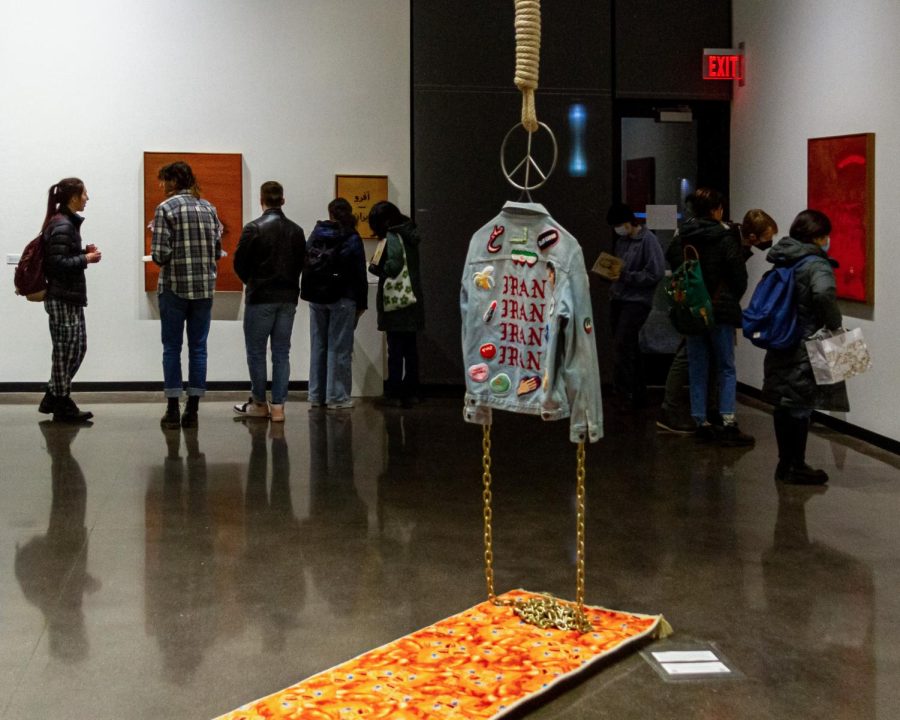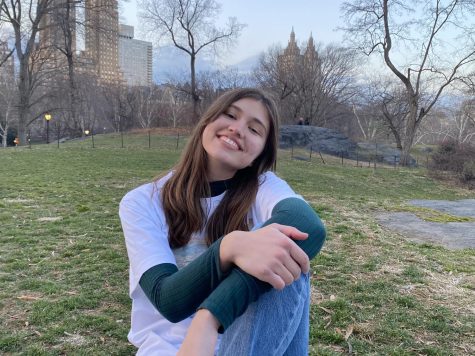“TARAVAT” gallery raises conversation and controversy
February 16, 2023
On Jan. 27, the Law Warschaw Gallery held its opening of the exhibition “TARAVAT”, showcasing Portland-based Iranian-American artist Taravat Talepasand’s signature work from the last 15 years. It was held like any other visiting exhibition Macalester has hosted. The artist was on-campus for the gallery opening where she spoke on her intentions and background in relation to the artwork. Shortly after the exhibition debuted, however, students began to speak out against the portrayal of Muslim women in the artwork.
Certain pieces in the exhibition include sculptures and drawings that portray women in hijab and niqāb half naked; Talepasand created these pieces as a way of protesting women’s rights under the Islamic Republic of Iran. The hijab has been compulsory for women in Iran since the 1979 Islamic Revolution, along with the ability for police to enforce it. According to the Australian Broadcasting Corporation, in Sept. 2022, protests in Iran escalated in response to 22-year-old Jina (Mahsa) Amini dying in police custody after being arrested for wearing her hijab too loosely. A commonly seen phrase used in these protests is “Woman, Life, Freedom,” which is included in the exhibition on the wall in neon lettering in English and Farsi.
One part of the series, a collection of graphite drawings and porcelain sculptures titled “Blasphemy,” drew particular attention to the sexualization of the women depicted. The series was based on photos of the Iranian writer Roxana Shirazi from her book “The Last Iranian Slut.” Talepasand said she was given consent to create this art based on Shirazi’s sexual liberation. “Blasphemy” offended many Muslim students as they felt it was targeting their religious practices. For many Muslims, the hijab is something holy that represents modesty and their choice to cover their bodies, and to have it presented in such a provocative way made these students feel targeted.
“There were a couple of minutes where I was sitting there, and when I started to speak … I just started crying,” a Muslim student, who wishes to remain anonymous said in describing their first interaction with the artwork. “I don’t think I’m a very emotional person, but for some reason … the second I started speaking I was just crying.”
It was reactions like these that led students to take the issue to administration. On Feb. 2, a group of eight Muslim students wrote a letter to the Macalester administration after collecting thoughts and feedback from dozens of members in the Muslim community. Within the letter they laid out their concerns about the gallery promoting stereotypes about Muslim women and the hijab. The main purpose of the letter was to inform Macalester administration about the extent of harm that the gallery caused many students, to demand Macalester hold themselves accountable for a gallery that went up without their knowledge and to put processes in place to make sure this does not happen again. They requested for the gallery to be removed and for trigger warnings to be posted.
A large issue for many Muslim students was how the gallery setting failed to provide proper context. Located in the Janet Wallace Fine Arts Center, one of Macalester’s academic buildings, the Law Warschaw Gallery is a room surrounded by glass walls. This both allows people to see the gallery from the outside and makes the space feel open for students to view the art. When entering the gallery, there are pamphlets that offer more in-depth information detailing the artist’s intentions behind the collection; however, it is not required to read it in order to view the exhibition. In this sense, Muslim students were worried that visitors of the gallery may interpret the art in a way not intended by the artist, but in a harmful way that could sexualize the hijab and hijab wearers.
“I think that the set up of a gallery where it sits in a building … and allows people to just be able to walk in and out, see the art, interpret it as they want and then just leave without knowing what the reason is for the art, what the artist was thinking; I think had the ability to perpetuate stereotypes,” the student said.
In response to the letter, members of administration, Art Department Chair Kari Shepherdson-Scott and Gallery Director Heather Everhart met, and decided to close the gallery for the weekend. On the afternoon of Feb. 3, black curtains were put up around the gallery during the decision process. Shortly afterwards, a school-wide email was sent out by Provost Lisa Anderson-Levy and Vice President for Institutional Equity Alina Wong, apologizing for the harm the gallery and art caused to Macalester’s Muslim community.
The act of veiling the artwork was seen as emblematic of the way the Iranian government has been forcing women to veil themselves. Although only meant to be a temporary action, it caused an uproar by both Talepasand and the Macalester community.
“I know it wasn’t intentional, but when the exhibition was closed, they covered it with black curtains … it was very poetic,” Iranian student Sheida Rashidi ’23 said. “Being censored with black curtains. I feel like I’m being followed by that … it felt like being censored again.”
Talepasand echoed this sentiment.
“It’s a whole new level to veil a ‘woman, life, freedom’ Iranian exhibition,” Talepasand said. “You literally did exactly what the protest is fighting against.”
Later that evening, administration invited students with a variety of perspectives to share their opinions and experiences with the gallery in person and discuss the way the event was handled.
There are constant conversations being held about freedom of speech and freedom of expression, and such Western ideals are often challenged when it comes to provocative art. When art offends certain communities, especially in a setting where these communities are marginalized, the question of what should or should not be shown on a college campus expands. There is also the question of what Macalester, as an educational institution, has the right to control and to whom they give a platform.
“I think it’s hard to know where to draw the line between artistic freedom and [what] should maybe not have a platform at a place like Macalester,” the student said. “However, I think there is an argument to be made that if something causes harm to a certain community, we should consider whether or not we should give it a platform.”
The gallery reopened Jan. 6, with the black curtains removed and replaced with purple paper on the door and frosted glass on the mezzanine, both at eye level, to prevent accidental viewing. On the door, a content warning said the exhibition contained “images of violence and nudity that may be upsetting,” and a poster asking visitors not to visit the gallery, to stand in solidarity and to protest the “objectification and fetishization of Hijabi Muslim Women.” A QR code attached led to a petition demanding the art be removed. The content warning has now been altered at the request of Talepasand, now simply mentioning nudity and urging viewers to use discretion when visiting.
Despite the pushback against reopening the gallery, some stand by the belief that all art should be given a platform, especially when it is meant to force the viewers to face difficult concepts and current events.
“I believe community care and academic/artistic freedom are not mutually exclusive,” Everhart said. “They can function … to bring more people together through art who might not feel invited or included.”
As a protest artist, Talepasand intended for the pieces to send a strong message against the Islamic government of Iran.
“My focus was to use this platform and this exhibition to highlight … what’s happening in Iran,” Talepasand said. “Maybe I would have left only certain pieces in the exhibition if I’d really known that the blasphemy series was going to have this effect on students.”
As a student personally affected by the events in Iran, Rashidi said, “it was really hurtful to see my people die, and then see someone who’s like ‘but why are they protesting in this way? Why is someone making this art?’ It was really frustrating and felt very invalidating.”
In general, there was a universal agreement that in an academic institution, the gallery should have had more context about the intention of the art and its contents.
“Because this exhibition was happening at Macalester, I agree that there should have been more context,” Rashidi said. “And maybe a warning should have been given. I think that was the biggest thing that was missing.”
Talepasand reiterated that the art was meant to be a reflection on the politics of choice.
“It’s more about where we are in America right now, as women fighting for autonomy,” Talepasand said. “I think a woman should have a right to do whatever she wants with her own body.”
Rashidi also had thoughts on artistic platforms.
“I understand their concerns, their experience and their hardships,” she said. “But at the end of the day my argument is not about you, it’s not about the Muslim community, it’s not about hijab and it’s not about Islam. It’s about Iranian people, women, fighting the Islamic republic of Iran.”
People had mixed reactions to the administration’s final decision with the gallery. Some felt the actions Macalester took were censoring the art too much, while others thought Macalester did not do enough. Some saw the response as an appropriate middle ground in which students are not unintentionally viewing the art, but the exhibition itself is still open for voluntary viewing.
“At the heart, [the hijab] was something important, dear and valuable to them, and to us it was something bad, and controlling and censoring,” Rashidi said. “Our hearts were in different places.”
The effects of the exhibition have also opened a discussion about how Macalester can support its Muslim communities moving forward, as well as keeping them involved in the decision making process about what is held on campus.
“I think it comes down to needing more people at the table when these decisions are being made about what’s brought into this campus and it can be students, but it can also be just people in the community,” the anonymous student said.
After many discussions within the Macalester community and the addition of the frosted glass and posted content warnings, the “TARAVAT” gallery will remain open until March 10 in accordance with the original contract with the artist.
*Carling McQuinn contributed to the reporting of this story.














Jay Mac grad and neighbor • Mar 19, 2023 at 12:42 pm
A well-done article. Here is the conclusion of a long essay I am writing on the subject. “Macalester’s “pause, gauze and reopen” response was a reasonable way to handle this situation. I hope that it has allowed for enlightening conversations and the strengthening of student tolerance and the sharpening of student criticism – which are proper goals for art like WOMAN, LIFE, FREEDOM and for colleges like Macalester.”
nontenuretrack • Feb 21, 2023 at 12:41 pm
“They requested for the gallery to be removed and for trigger warnings to be posted.” Okay, but in the Hamline example, the instructor offered MULTIPLE trigger warnings and was roundly criticized for having done so because, according to some, offering a trigger warning indicated the professor knew they were doing something wrong. What guidance can we expect from the offended students about this? Or are the rest of us just supposed to guess when trigger warnings are appropriate and expected vs precursors to inflicting intentional harm?
What is happening at Mac and Hamline is censorship. Censorship is wrong and it’s deeply concerning. Administrations are both institutions have shown us all that they are much more conservative and reactionary than they present themselves to be. I’m so curious to see how these two situations will affect future enrollment at both institutions given that the veil has now definitely dropped.